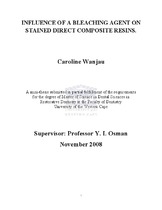| dc.description.abstract | Despite the phenomenal strides in research of dental resin composites regarding their physical
and mechanical properties, discolouration, either intrinsic or extrinsic still remains a major
drawback and is one of the main reasons for the replacement of these restorations. Toothbrushing
and polishing procedures have been attempted to eliminate extrinsic staining without optimal
results. Vital tooth bleaching has over 90% success rates in whitening discoloured teeth and this
may be an alternative treatment modality for discoloured composite resins. Aim: The aim of this
study was to determine whether tooth bleaching agents alter the colour of stained direct
composite resins. Material and Method: 60 disc shaped specimens (9 x 2mm) of Filtek
Supreme XT were prepared. They were randomly divided into 3 groups (n = 20) and exposed to
either one of two experimental staining agents, tea or red wine, or artificial saliva (control)
continuously over a 7-day period. They were all then bleached with Opalescence Xtra Boost, a
chemically activated in-office whitening agent for 3, weekly sessions of a half hour each, broken
into 2, fifteen minute cycles. Colour determinations were made using a reflectance
spectrophotometer, from baseline, after each day of staining, after the bleaching treatments and
after a 1 week rehydration period. The CIE Lab colour space was used and colour changes were
monitored using ΔE, that was calculated during intervals between the experimental episodes
using L, a and b values. A ΔE ≥ 3.3 represented colour changes that were deemed clinically
noticeable. Data analysis was carried out using Microsoft excel and a non-parametric test
(Wilcoxon Signed Sum Rank Test) with a significance level set at ≤ 0.05 for colour differences
that are statistically significant. Results: Both staining solutions discoloured the composite resin
samples, but red wine produced greater colour changes than tea. After bleaching, the specimens
in the tea group reverted to baseline colour with a ΔE ≤ 3.3 but those in the red wine group did
not revert to baseline values with a ΔE ≥ 3.3. Conclusion: Filtek Supreme XT, a nanocomposite,
is susceptible to discolouration by chromogenic beverages. Red wine produced deeper staining
than tea. Opalescence Xtra Boost was effective in removing tea stains but not red wine stains. | en_US |

